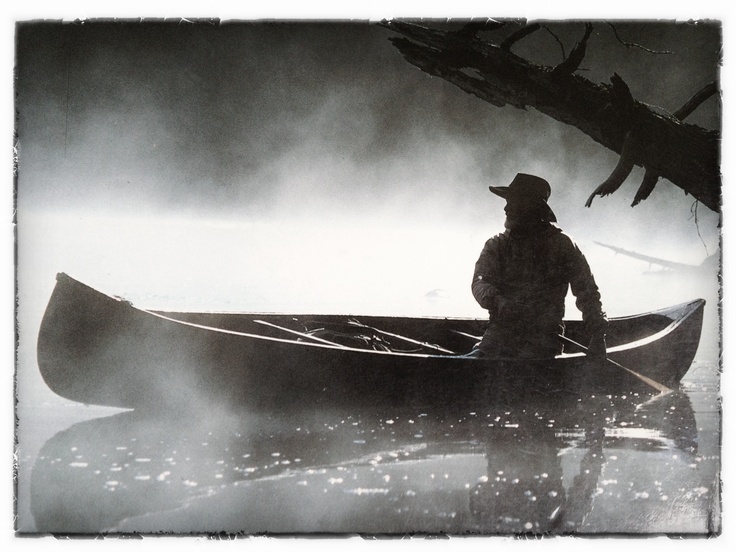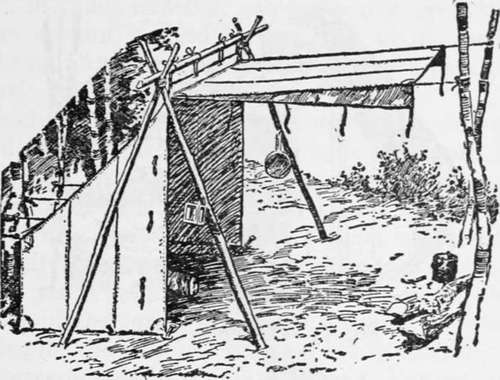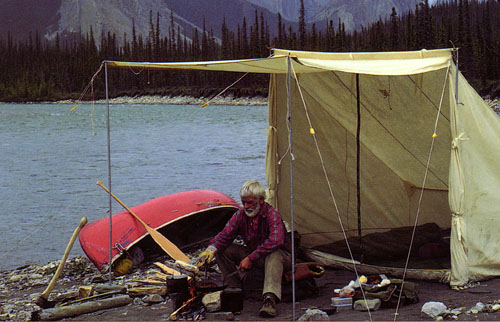By Sean Fagan
Baker Tents, Canoes, Bears, Ancient Cultures
&
Taking your Time to Explore a Wilderness...
.
.
Bill Mason was an outdoors person to the very marrow of his being.
He simply couldn’t get enough of wild places.
In his semi-autobiographical documentary, Waterwalker, Bill explores the magnificent Northern Woods and waterways of his beloved Canada (Link to documentary below article).
With only a well-stocked canoe, Bill would often spend months paddling around some of the greatest tracts of wilderness on our planet.
His approach to the wild was elegant, robust and well-tested.
He was the epitome of simple outdoor living.
Bill's exemplary outdoor skills combined with his passionate attitude for the outdoors, compensated for any lack of comforts (real or imaginary) that comes with living outdoors.
Who needs hot water, TV or a good Wi-Fi signal when you can comfortably live in an incredible wilderness? It’s hard to put a price on the sense of freedom that Bill savoured for most of his life.
There is so much to learn about outdoor living from watching Waterwalker.
I hope you enjoy the 4 outdoor lessons I have compiled about Waterwalker and about the great man himself - Bill Mason.
.
1. Taking Your Time to Explore & Relax
.
As a wilderness artist, Bill travelled on the rivers and lakes of Ontario at an easy pace.
Throughout the documentary, you get a sense that Bill wanted to savour every moment.
This leisurely yet observant attitude which Bill displays throughout the documentary is in complete contrast to how some individuals behave whilst in places of outstanding beauty and wildlife.
It can be discouraging to witness many outdoor enthusiasts treating the outdoors as a testing ground - a place solely for improving and testing fitness, endurance and mental grit.
Many of these individuals trundle through stunning landscapes with mileage, pace and destinations foremost in their minds.
Consequently, they often miss a lot of the beauty and drama that often unfolds in wild places.
Surely wild places are free-spirited domains where packed itineraries and our sometimes stifling desire to achieve can be temporarily curtailed for our own betterment – especially when we are surrounded by a landscape that begs to be explored at a somewhat leisurely pace...
...a landscape that rewards close inspection and curiosity.
However, I don’t mean to be too critical. The fact that people are out and about in wild places is a great thing and each to their own.
And I certainly don’t mean to diminish the value of a well-structured, outdoor itinerary.
Its just nice, on occasion, to explore nature in a more spontaneous, more curious manner. That can be hard to do if the mind is overly preoccupied with ticking off a to-do list.
.
2. Bushcraft Can Create a Respect for Ancient Cultures
.
Bill peppers his documentary with some well-chosen quotes from prominent First Nation individuals.
I believe that bushcraft, when practised enough, draws us into a landscape at a deeper level than most other outdoor enthusiasts which can create a curiosity about the history of human occupation - especially prehistoric human occupation.
This is partly because, bushcraft at its core, favours a minimal equipment and knowledge-and-skills-rich approach to the wild.
Invariably, some of the more traditional bushcraft skills, such as fire-lighting, natural navigation, tracking etc. can cast us, vicariously, into the reality of humans from the past who relied heavily on such bushcraft skills to survive.
A lot of bushcraft, in a way, is a form of experimental, primitive anthropology. Big words, but what it means is that many bushcrafters are doing things that primitive hunting and gathering societies did in our distant past…
…and that can be exciting.
Exciting, and humbling – for when we tap into the formidable skill base, ingenuity and knowledge of, for example, hunting and gathering people we realise how extraordinarily capable these people were.
We can become far more attuned to what they faced, day in and day out, and the daunting demands of survival in a rugged, often unforgiving landscape.
It’s a nice touch that Bill pays considerable homage, throughout his documentary, to the First Nation people who dwelled throughout Canada (and the rest of North America).
They deserve our admiration.
.
3. Bill's Canoe & Baker Tent
.
An aspect of the documentary I really like is Bill's affectionate attachment for his canoe. Even though, obviously, a canoe is an inanimate object, Bill knew the true value of essential kit (like a lot of bushcrafters that heavily rely on essential gear).
When you truly depend on bushcraft kit such as a knife, an axe or even a canoe, and they consistently preform well, it's hard not to form a close bond that can seem sentimental - but it's not.
Rather, its an attitude of respect and gratitude.
What also impressed me - was Bill's fondness for the seemingly antiquated baker tent.
Bill wanted, at all times, to be connected to nature - being cocooned in an enclosed tent was not Bill’s idea of enjoying and connecting with the wilderness.
The baker tent is an old style, open-fronted, canvas tent. Despite the fact that Bill was travelling through bear country he still opted for an open-fronted baker tent.
Baker tents can be heavy and bulky to transport but Bill loved the roominess, openness and robustness of his baker tent.
In a world where a lot of people and their dogs wants the latest, most fashionable outdoor gear it's refreshing to see someone, who through considerable outdoor experience, made up his own mind as to what he liked regardless of how old fashioned his choices may have seemed.
Bill could also enjoy and savour the many benefits of a campfire in front of his open shelter - for drying damp clothes, cooking, heat, repelling biting flies etc.
Also, watching the embers and flames of a fire, while in bed, is a deeply relaxing experience that certainly adds an extra layer of enjoyment when outdoors.
.
4. But What About Bears?
.
Intelligent, curious, immensely powerful, athletic and occasionally temperamental - bears can easily outrun, out-climb and out-swim humans - they are to be treated with respect.
But it’s a curious thing, when I’ve been in Canada myself - I received many a warning about bears, often from people that had limited experience of the outdoors.
And yet I have safely solo-travelled through bear country in Canada, as did Bill.
I've came across quite a few bears on my travels – and they struck me as shy and wary of humans and would generally bolt away as soon as I was detected.
I always carried bear spray and took necessary precautions such as walking in the open when possible and practised good food management to discourage the curiosity of opportunistic bears.
I was careful - because complacency could have had serious consequences and just as importantly - I wanted the mental confidence to wander as much as I wanted in the Northern Woods of Canada.
Bears generally shy away from humans and Bill, I believe, obviously knew this. Sometimes the reputation of bears far exceeds their actual level of threat.
When it comes to the vast woods of Canada in summer - getting lost, biting insects, mechanical injury such as a twisted ankle or knee, dehydration and heat stress are some of the more realistic and prevalent irritations and threats.
Nevertheless, don’t take my experiences and opinions of bears as sacrosanct.
I can’t, in good conscience, predict - for people reading this article - the behaviour of complex mammals such as bears. You have to take your own risks according to reliable local knowledge, research, training, good judgement and best practise.
However statistically, the chance of fatal black bear attack is extremely low where Bill did most of his solo excursions (Ontario).
Again, I’m certainly NOT encouraging a complacent attitude to bears. Bears can be dangerous.
I'm just offering, what I hope is, a reasonable counter argument against the many excessively negative and exaggerated opinions about bears, specifically black bears.
What's great - is that the presence of bears did not deter Bill from exploring, for many years, great swathes of Canadian wilderness - which speaks volumes.
.
..
Concluding Thoughts...
I think I speak on behalf of many bushcrafters and outdoor enthusiasts that inspiring, outdoor documentaries such as Bill Mason’s Waterwalker can stir a sense of adventure within us - often compelling many of us to get out there and explore wilderness.
In that regard Bill did a great job,
Thanks Bill.
(Don't forget to watch Bill's Waterwalker documentary below...)
.
....
Have safe & Great Adventures,
Pioneer Bushcraft.
.
.
Related articles on this website:.
Resources:
Check out Bill Mason's Waterwalker documentary below...
.
..
.
PIONEER BUSHCRAFT DISCLAIMER
.
The aim of this article is to provide advice that will enhance the quality of your time, and well-being, when outdoors.
Pioneer Bushcraft does not take any responsibility for the misapplication of advice in this article.
The advice in this article is very much an adjunct to, and not a substitute for, high-quality bushcraft training (including outdoor medical training), relevant research and experience, trustworthy local knowledge, thorough risk assessments and all other health & safety considerations specific and pertinent to your outdoor excursions.
Please – when outdoors, take responsibility for your well being seriously.
It can make all the difference between a great or bad outdoor experience.




Recent Comments